Published February 28, 2023 | Updated February 28, 2023 | 7 minute read
OKRs (Objectives and Key Results) are critical for aligning common goals across an organization. But for many leaders and managers, particularly at mid or lower levels, OKRs can seem huge and abstract.
Understandably so! Whenever someone hasn’t participated in choosing a shared goal, it’s hard for them to feel personal ownership over their role in making it happen.
But the OKR process can actually be very motivating and engaging at every level, if leaders and managers at every level know how to use it.
In this blog, I’ll share an OKR framework we use in our leadership development work at August. Senior leaders can use this framework to help leaders and teams throughout the organization take ownership of their roles in company-wide OKRs, and design their own team-based OKRs in response.
Intro to OKRs
OKRs are the bridge between strategy and execution. They help everyone in an organization align on three key questions:
- Where do we want to go? (the Objective)
- How will we know we’re getting there? (the Key Result)
- What will we do to get there? (the Initiative)
To get more nitty-gritty: The Objective is a qualitative, high-impact, time-bound goal that aligns the organization with its overall purpose. A Key Result is a specific, measurable, achievable step that helps move the objective forward. An Initiative is an action that drives a particular Key Result.
Are you drowning in abstraction yet? Here’s a chart to help visualize this relationship:
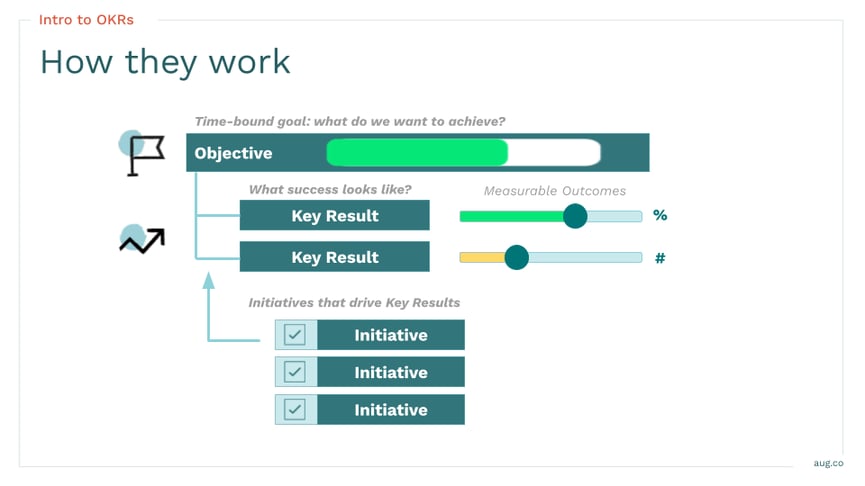
An organization’s OKRs are necessarily large and ambitious. But we all know that big goals are achieved through small steps.
This is where mid-level leaders, managers and teams play a crucial role. They are by far the best positioned to assess and strategize how they can best contribute to company-wide OKRs.
Our framework empowers these individuals and teams to design their own OKRs within those of the greater organization.
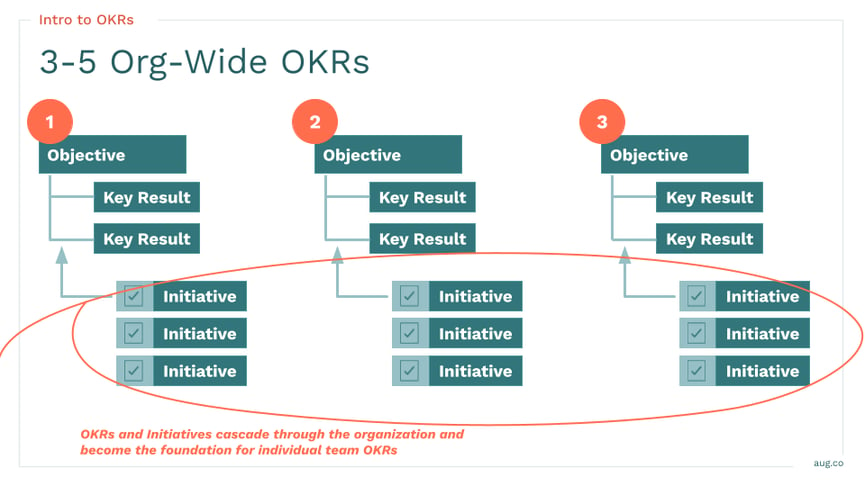
OKR Training: Start With a Game!
If this is still feeling abstract and acronymmy (sure, that’s a word), chances are that’s how your leaders and teams will be feeling too when you explain it to them. So let’s shake things up with a game!
I love games for helping people discover and adopt new ways of thinking. This game is designed to help participants connect to the tangible meaning of each component of an OKR, from the Objective (and the Purpose that drives it), to the Key Results (and the Initiatives that drive them).
(Props to our consultant Ashley Simcox for collaborating with us to create this game!)
You can access an interactive version of this game via Google Slides, but the general gist is this:
Of all the options below, can you pick out 1 Purpose, 3 Objectives, and 9 Key Results?
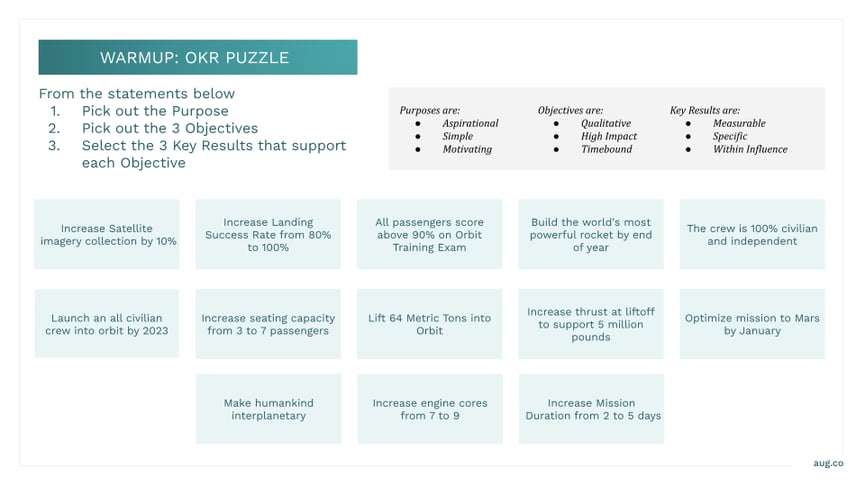
Here’s a simple video to animate this process step by step. Feel free to pause the video at each step and challenge yourself to answer the prompt!
When facilitating this game, you can have large groups respond via a collaboration tool like Miro or Mentimeter. In smaller groups, simply call on raised hands or let participants respond in the chat.
This is a fun way to activate different learning styles, and help each team member internalize the relationships between each component of an OKR.
Breaking Down the OKR Framework
Once your group understands the different components of an OKR, it’s time to practice the OKR design process.
Use your current company-wide OKRs as examples to practice each of the following steps.
Step 1: The Lookback
The Lookback is a team review of existing goals and strategies, to ensure any new OKRs align with the current mission. This is a crucial first step in creating new OKRs.
In the Lookback, the team spends time together reviewing relevant organizational documents such as the annual strategic plan, team goals or budget, and noting any important themes and criteria that should be kept top of mind when drafting new OKRs.
For example, after reviewing the strategic plan, a team may establish that there needs to be at least one objective that focuses on product development, and another that focuses on inclusion and belonging.
For the purposes of this exercise, review the current company strategy and goals as a full group.
Step 2: Choosing Objectives
Next, get the group thinking about how to reframe company-wide Objectives from the standpoint of their team’s unique contribution.
For example, an individual team might not be capable of single-handedly achieving the goal of maximizing the potential of each of the company’s brands – but it can contribute to that company-wide Objective using the team’s particular specializations and skills.
Step 3: Laddering Up
Not every team can contribute equally to every org-wide objective. That’s the whole point. Teams should identify which company-wide Objectives they have the capacity to support, and create Key Results that articulate their intended contribution.
For this exercise, have the group look at each Objective and determine if it is possible for them to support it. If no, move on to the next one.
Step 4: Choosing Key Results
Now comes breakout group time!
Have the group break into teams, one per Objective, and give them time (at least 30 minutes, ideally more) to brainstorm on this prompt: What are up to 3 KRs are we going to use to achieve this objective?
Teams can discuss however many they like, but should come back prepared to propose only three. This forces the team to prioritize a few core metrics, which is one of the big benefits of the OKR system.
When needed, teams can capture KRs that don’t ladder up to their Objective in another document, then get back to brainstorming for their Objective.
After the allotted time, each team presents their proposed Key Results to the group.
The group should spend some time discussing the proposed Key Result, with a goal of confirming up to three KRs per Objective.
Some guidelines for designing great Key Results:
A good Key Result is measurable, specific, and within your control. Its primary purpose is to make the Objective achievable, so it outlines a precise but ambitious step towards that mission.
To return to our Interplanetary Game analogy, each Key Result is both ambitious and precise in its relationship to the Objective:
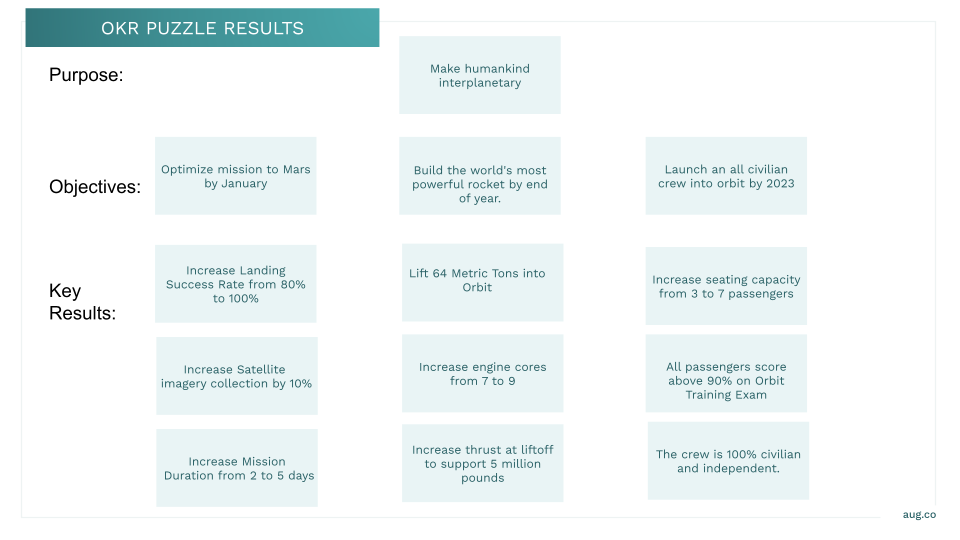
Step 5: Designing Initiatives
Initiatives are the “how” to an OKR’s “what.” They are the actual projects that activate and achieve an OKR.
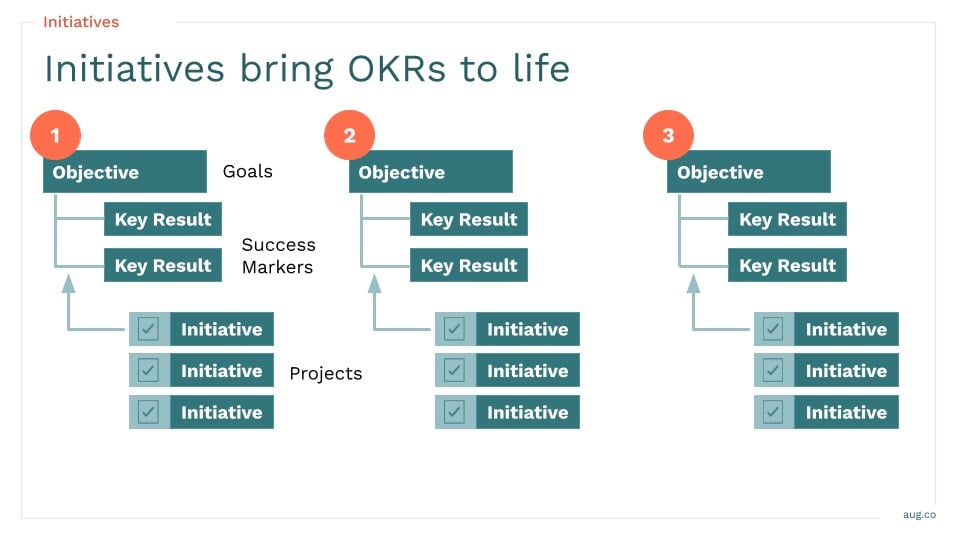
The best initiatives are:
- Clearly defined and active, containing action verbs like “establish”, “write”, or “launch.”
- Within your control. If an initiative is beyond your power to complete, it is not supportive of the OKR.
- Prioritized by their likely impact on the Key Results.
- Challenging and dimensional. An initiative shouldn’t be overly complex, but it’s much more than a simple task.
Break into teams again (either randomly assigned or grouped by function within the department). Give them 30 minutes to brainstorm on the prompt: What are the 3-5 Initiatives we will use to achieve our OKRs?
Teams can discuss as many as they like, but should come back prepared to propose three.
Then as a full group, look for overlap between the proposed initiatives. The goal is to synthesize the multitude of proposed initiatives down to a core list of ten or less. (This step may need to be completed asynchronously, with a compiled list of options that everyone reviews and votes on.)
Step 6: Review and Measure Results
Conclude your OKR training with this message: An OKR is only helpful if you measure its outcomes and learn from the results!
OKRs should be reviewed quarterly, and renewed or updated annually.
At each quarterly review, take note if progress seems either too easy or difficult, and refine the OKR to hit the sweet spot between the two. OKRs should be slightly difficult to achieve, but not impossible. If they’re stretching and challenging you, that’s a good thing. If they're sailing along on perfectly smooth seas, you’ve probably set the bar too low.
At quarterly reviews, teams should ask questions such as:
-
Has anything happened that would change our Objectives?
-
How does our measurable progress towards our Key Result compare to our goal?
-
Are we looking at the right indicators to measure progress against our Key Results?
-
What should we do next to continue progress towards our Key Results?
Use a Tracking Sheet to record, monitor and share your OKR progress. You can use this sheet to establish a quantitative scoring system if you wish, or you can use a qualitative system that asks questions like: “How are we doing against this Key Result?” “What’s next?”
Want to know more? Check out these OKR materials from Google’s re:Work.
OKR Training helps teams find their role in company objectives.
With the right framework, OKRs can be an empowering tool for instilling ownership of company-wide objectives throughout the organization. They help drive focused innovation, and help everyone connect to a shared purpose.
Use this blog to guide your OKR training for your teams – or we can facilitate this for you! I’m always happy to talk about how August can help your leaders strategize their contribution to company-wide OKRs.


.jpg)






